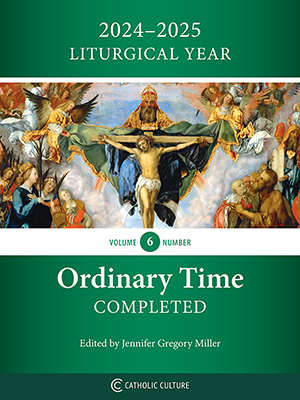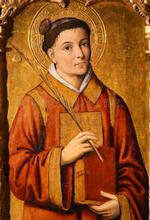Did “Vatican II” really trigger a decline in Catholic practice?
By Dr. Jeff Mirus ( bio - articles - email ) | Aug 14, 2025
I’ve been wanting to get back to Phil Lawler’s commentary on Vatican II’s relationship to Catholic decline, which he posted on July 28th. This desire is fueled by the perennial need to avoid misunderstanding. For example, no reasonable observer of Catholicism in the 1960s can fail to recognize that the overall “phenomenon” of the Second Vatican Council included a concerted effort by Catholic intellectuals to undermine the perennial teachings of the Catholic Church. In that sense, Vatican II served as a kind of trigger for what we might call an effective secularization of the Church.
Free eBook:

|
| Free eBook: Liturgical Year 2024-2025, Vol. 6 |
But that is a proposition far different from the claim that the actual work done by the Council and promulgated by Pope St. Paul VI in the Conciliar documents was inherently secularizing. No careful and honest reading of the actual texts will support that claim. Partly as a demonstration of that point, but mostly to elucidate what the Council actually taught, I wrote a series of 34 articles on that subject in 2010, which is still available here on CatholicCulture.org, beginning with A funny thing about Vatican II . . . . This series reviews the fundamental content of each of the Council’s documents.
But timing is everything
It is no wonder, of course, that the ongoing reception of the Council was characterized by an enormous secularization among Catholics, a problem that did not really begin to be corrected in earnest until Pope St. John Paul II moved to regain control of the “conciliar narrative” at the Synod of Bishops held in 1985, some twenty years after the Council had promulgated its papally-approved texts. Indeed, a process of intense secularization was well-advanced throughout Catholic academia and Catholic media by 1960, influenced tremendously by the wave of relativism which swept the world after World War II. Nowhere was the trend more pronounced than in Catholic colleges and universities. All of this kept pace with the larger secular world throughout that decade, as anyone who lived through those years knows (whether they were in favor or opposed).
The times they were a-changing. The fifties were still largely safe for most families, but the sixties were deadly in ways that caught many Catholics by surprise. For example, this was the decade in which it became almost impossible for unsuspecting parents to send their children off to Catholic (let alone secular) colleges and expect them to return home with their faith intact. Almost overnight, the floodgates of a prosperous secularism were wrenched open and, to mix the metaphor, what had been incubating in academia in the previous decades, but was somewhat constrained by the perils of depression and war, leapt full-grown from the head of Satan in a postwar era of prosperity and forgetfulness of the terrors of life.
Some of us started fighting the hydra in those same 1960s. Forewarned by a few prescient priests, I began writing my first articles defending the Faith in the same year I went off to college, the year after Vatican II completed its work. But the most obvious point to make is that the dominant Catholic intelligentsia had already been secularized before the Council documents were promulgated, and the same was largely true of the Catholic press, which had spearheaded the distortion of the Council from even before it convened in 1962. Certainly those trends were exemplified by some of the Council Fathers and their theological advisors, but not by the majority, and under the guidance of the Holy Spirit, the documents promulgated remained sound.
But perhaps the most accurate way to describe this is that Catholic university professors, particularly theologians, had been sliding down the Modernist slope fairly quietly behind the scenes already for two or three decades, and that the secular atmosphere of the 1960s almost immediately brought it all out into the open. What had often been hidden or even sometimes suppressed to some degree even as late as the 1950s became open, popular and in demand as soon as the dominant and enormously prosperous post-war Western culture began to shift to open secularism.
Speaking carefully
Things were very bad generally until the tide within the Church began to turn very slowly in the mid-1980s. During the pontificate of St. John Paul II there was a long ideological “battle for Vatican II” which continued under Pope Benedict XVI—an insistence on making sure that the so-called “spirit of Vatican II” was properly informed by the letter of the texts. The high point of the papal battle may have been the publication of the Catechism of the Catholic Church in 1992, which quoted the conciliar texts with some frequency. Moreover, the whole point of Pope Benedict’s “hermeneutic of continuity” was to emphasize that new magisterial texts must always be interpreted in the light of all prior magisterial texts. It is always illegitimate to interpret them as if they mean to supplant rather than to clarify and extend what the Church has already taught.
Speaking carefully about Vatican II, then, it is necessary to distinguish between what we might call the overall “phenomenon” of the Council—that is, the immediate historical impact of the Council on our senses—from the ultimately more important contribution the Conciliar texts made to our overall understanding of the full truth of Jesus Christ and His Church. It is one thing to argue that the overall “phenomenon” of the conciliar event as it was publicized and interpreted served to aid and abet the rise of error. That is certainly true, and it was going on very rapidly in the press and academia even while the Council was still in session. But it is quite another to understand how far astray this social phenomenon went from the conciliar texts themselves.
Could more be said and written now to clarify many things further, along with new emphases in the light of what has followed? Certainly. Yet it remains true that the majority of those who speak most loudly about the Second Vatican Council and its impact have still not read the Conciliar texts—and they would be substantially better Catholics if they did. The overall phenomenon, as it impacted the minds and hearts of Catholics when it was as yet only a widely-acclaimed mood, may have triggered any number of bad results. But despite the need for ongoing clarifications of what, in any Magisterial text, may at times be misunderstood, the conciliar documents themselves were neither worldly nor relativistic.
No text can anticipate every future misinterpretation or objection. Churchmen, above all others, ought to be able to read responsibly. The work of the Church’s magisterium is ongoing. But the historical phenomenon of any ecumenical council in its time must always be distinguished from the texts themselves. Indeed, in the case of the Second Vatican Council, it was the deliberate widespread and ongoing effort to pre-empt a proper understanding of those texts which constituted the overall phenomenon.
We do well to remember that a “phenomenon” is “an aspect known through the senses rather than by thought”. As always, we must distinguish carefully what may be competing for our attention as Catholics from what Christ and the Church have actually taught. So it is with the phenomenon of the Council and the letter of its texts. Indeed, in a fallen world, the two are only very rarely the same.
All comments are moderated. To lighten our editing burden, only current donors are allowed to Sound Off. If you are a current donor, log in to see the comment form; otherwise please support our work, and Sound Off!
-
Posted by: djw2e6874 -
Aug. 19, 2025 10:08 PM ET USA
Are the document inherently secularizing? No, but there are problematic passages in the documents which can be difficult to square with the deposit of faith and open up to secularization. And, as an attempt to engage (evangelize?) the modern world, it seems a failure whether that is the documents or everything done in the name of the council. One wonders if the Church would have been better without the council. There is no guarantee of protection from bad projects started with good intentions.
-
Posted by: kmmcki -
Aug. 17, 2025 5:09 PM ET USA
Significant changes were made to the Mass to make it more relevant to our modern lives. But doing so removed the Spiritual Mystery and Awe of God and made of it an ordinariness of the ordinary. Explains why one-third of the pews are empty following communion. Pope Francis WOKE the Church and Existentialist philosophical tendrils are now reaching every corner of the Vatican. The Conciliar texts can't bridge the gap btn prior & post Vat II if they never reach down to the humble Parish priest.
-
Posted by: PFM5899 -
Aug. 17, 2025 11:27 AM ET USA
As a convert to the Church in the early 80's, I quickly recognized the problems experienced post Vatican II were already there and as you have said were exploited by those who wanted to secularize the Church. However, it also appears to me that the laity were poorly catechized: they, especially the Roman laity, had difficulty separating the unchanging theology and dogma from the changes, made too quickly, in liturgical practice, which we know have changed throughout the centuries.
-
Posted by: rfr46 -
Aug. 17, 2025 5:39 AM ET USA
I admire your excellent analysis of the distinction between phenomenon and texts of Vatican 2. However, wise men & women who write institutionally sanctioned texts must anticipate distortions of the texts in the direction of prevailing influences of the phenomenon.This obviously did not sufficiently occur. Nor did the Church's post V2 leadership react timely and effectively to the manifest abuses of the texts. Corrective reaction still required.
-
Posted by: Randal Mandock -
Aug. 15, 2025 9:36 PM ET USA
It could not have been said better.
-
Posted by: Crusader -
Aug. 15, 2025 10:00 AM ET USA
When the weatherman says it is sunny, but it is pouring down rain, I think, Just look out the window. I do not mean to be critical, but this seems like an academic classroom discussion. Look out the window. Where is the measurable improvement in the Church, even since the 1980's that you mention? After sixty years I see Vatican II as similar to Lateran V - valid, but of no measurable help. The bishops said they were reading the signs of the times, but they apparently did not read it correctly.
-
Posted by: gskineke -
Aug. 14, 2025 7:04 PM ET USA
There was the Council and there was the “new Mass.” Although many have argued about whether the Novus Ordo was what the Council prescribed, it was the immediate encounter with the post-Conciliar Church. Decades of unserious, untethered Masses outweighed the documents (read or unread) and the people headed for the exits. How does one explain to the average layman that despite the radically changed landscape (both parishes & schools) it really was still the same Church and the documents are fine?







